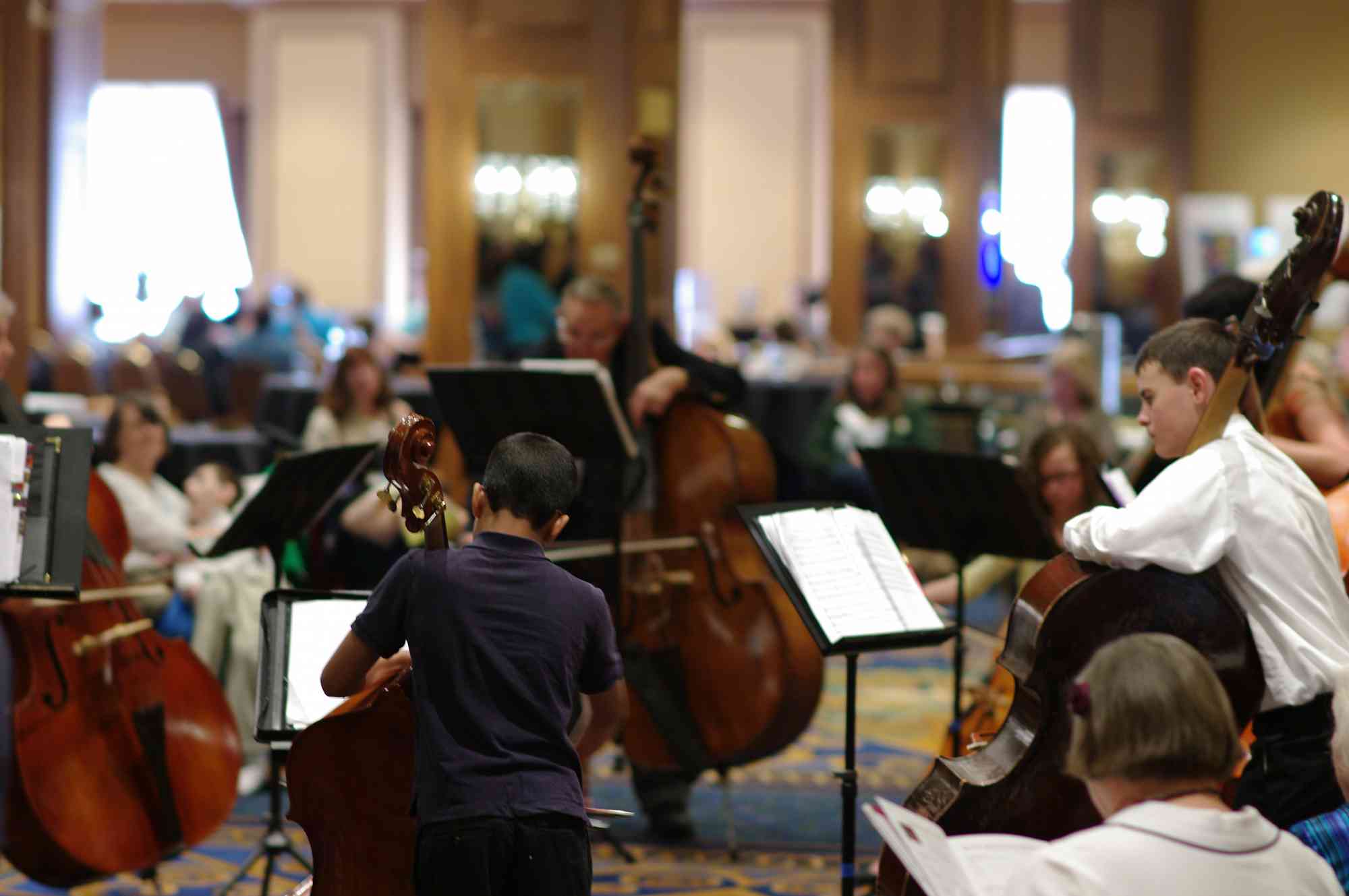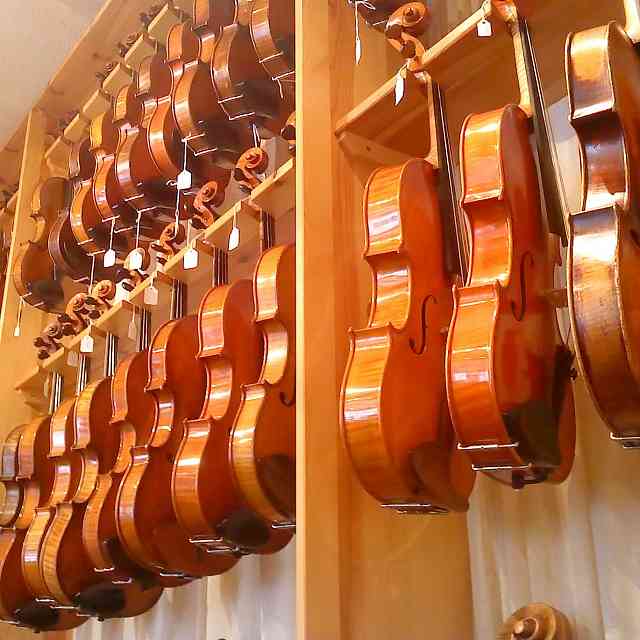Third in an educational series sponsored by Robertson & Sons Violin Shop
Well, talk to any bassist and that’s what they’ll tell you. Bassists are a breed of their own, deeply committed to the low tones, the amplitude, and the life-size reflection of the human figure. The bass is intrinsic to every musical genre, from jazz to rock and roll, from country to classical. Its role in harmonic construction is the foundation upon which all else is built. All hail the magnificence of the double bass!
The ancestry of the double bass can be traced back to as early as the 15th century. Given that the spruce top of a bass depicts about 300 years of tree growth, you can begin to see that the organic beginnings of any given bass predates its crafting by centuries. That means that a tree planted today would have to grow undisturbed until the 24th century in order to yield a bass! It’s no wonder that other materials have been explored for making basses. Many student basses are made of laminated wood in order to reduce expense and improve durability. For a time in the 1930s, Alcoa produced an upright bass made of aluminum. Some modern makers are experimenting with carbon fiber as a viable material.
It does require a certain fortitude to tackle an instrument of such large proportions. The playing of it demands athleticism quite unlike most other instruments. The sheer mass of the instrument makes it more susceptible to temperature and humidity than smaller stringed instruments, resulting in frequent cracks and open seams. Transporting the instrument is an imposing task; just getting it into the next room without bumping the door frame is problematic, but transporting it via automobile or air can take herculean effort as well as specialized equipment. As a result, few basses have survived an active performing career unscathed. Evidence of hasty repairs, performed by carpenters without proper tools, wood, or experience, are all too common. Tragically, some old basses have even been painted to cover their indiscretions! You might imagine that due to the size, a bass would cost more than a violin, but because they are often badly damaged and poorly repaired, older hand-crafted basses tend to be less expensive than their smaller counterparts.
The bass has been elevated to a new level of respect in recent years due to the remarkable performers that have emerged in the classical arena. According to Aaron Robertson, a graduate of the Curtis Institute of Music and bassist who has performed regularly with the Philadelphia Orchestra, “Now, more than ever, we are hearing the bass played as a solo instrument. Artists such as Edgar Meyer, Hal Robinson, Daxun Zhang and Catalin Rotaru are performing major works on the bass including the Bach Six Suites for Solo Cello, the Brahms Cello Sonata, and various major works for violin. And they are performing and recording them at levels beyond, or at least comparable to, the great performances on the instrument for which they were originally written. Furthermore, the great pedagogues such as Paul Ellison and Hal Robinson have been instrumental in developing a new standard of technique that has drastically changed the way bassists approach the instrument. In the last ten years, the level of playing has absolutely skyrocketed! All in all, we are definitely in a renaissance of the double-bass.”
All of this excitement has put lots of pressure on luthiers and bass manufacturers to raise the level of the basses they make. Simple aspects of general set-up have changed on the bass. The most prevalent change is the increase in the overstand (the distance between the bottom of the fingerboard and the top of the body at the neck joint) and projection of the neck. The increased overstand greatly enhances the playability of the instrument allowing much easier access to the upper registers. The increased projection helps increase the power and volume of the instrument. On older instruments, in addition to the changes in overstand and projection, the string length is also shortened to achieve a more player-friendly length. This is accomplished by means of a restoration procedure called a scrollgraft. The restorer designs and constructs a new neck that satisfies the changes to overstand, projection, and string length. Then the new neck is spliced onto the instrument’s original scroll and peg box. This repair results in the modernization of an older instrument.
The trend for a bass to be used as a solo instrument has also engendered a change in the shape and length of the fingerboard. New fingerboards are now being fitted which allow players to reach notes that are one to four notes higher than the older boards would allow. Low-C extensions have also become a common request from bassists, expanding the playing range in the opposite direction. The changes in playing style have made it crucial for bass restorers to work closely with the players to create an instrument that will accommodate contemporary technique as well as individual preferences.
It is rare to find a stringed instrument dealer that has the space to maintain a large inventory of basses or the expertise, manpower, and tools to restore basses to their original splendor and provide modern adaptations. Robertson and Sons Violin Shop offers an impressive inventory of basses in all price ranges. Since the demand for small basses has increased dramatically in recent years, Robertson’s also carries the spectrum of smaller-sized basses. In addition, Robertson’s employs a team of experts devoted to setting-up, maintaining, restoring, improving, and making basses and bass bows. In fact, Chris Pedersen, a maker and restorer on the Robertson’s bass team, says, “This is really a bass shop that sells violins—and it does a better job of selling violins than most violin shops!” Over time, the sheer volume of bass work has allowed the team to study and compare the basses created by the great makers, to learn the preferences of performing artists, and to incorporate those ideal qualities into the basses they make and restore. Aaron Robertson, says that “a bass should reward you for playing well. It should be capable of producing variations in tone and color so that you can learn to play well.” David Briggs, formerly with Bein & Fushi, works solely on bass restorations. Aaron claims that “David does the best low-C extensions in the country. No matter where bass players obtain their instruments, they send them to David to get “The Robertson Set-up.”
So, given the tribulations inherent in playing these venerable and bulky giants, perhaps bassists deserve a little leeway in the attitude department. Let’s strengthen the roots of our string family by encouraging children to appreciate the bass and all of its diversity. More power to the “Basses are Better” Club!










